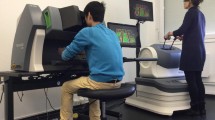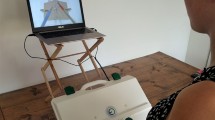Abstract
In robotic surgery, the coordination between the console-side surgeon and bed-side assistant is crucial, more than in standard surgery or laparoscopy where the surgical team works in close contact. Xperience™ Team Trainer (XTT) is a new optional component for the dv-Trainer® platform and simulates the patient-side working environment. We present preliminary results for face, content, and the workload imposed regarding the use of the XTT virtual reality platform for the psychomotor and communication skills training of the bed-side assistant in robot-assisted surgery. Participants were categorized into “Beginners” and “Experts”. They tested a series of exercises (Pick & Place Laparoscopic Demo, Pick & Place 2 and Team Match Board 1) and completed face validity questionnaires. “Experts” assessed content validity on another questionnaire. All the participants completed a NASA Task Load Index questionnaire to assess the workload imposed by XTT. Twenty-one consenting participants were included (12 “Beginners” and 9 “Experts”). XTT was shown to possess face and content validity, as evidenced by the rankings given on the simulator’s ease of use and realism parameters and on the simulator’s usefulness for training. Eight out of nine “Experts” judged the visualization of metrics after the exercises useful. However, face validity has shown some weaknesses regarding interactions and instruments. Reasonable workload parameters were registered. XTT demonstrated excellent face and content validity with acceptable workload parameters. XTT could become a useful tool for robotic surgery team training.


Similar content being viewed by others
References
Liu M, Curet M (2015) A review of training research and virtual reality simulators for the da Vinci surgical system. Teach Learn Med 27:12–26
Abboudi H, Khan MS, Aboumarzouk O, Guru KA, Challacombe B, Dasgupta P, Ahmed K (2013) Current status of validation for robotic surgery simulators—a systematic review. BJU Int 111:194–205
Torkington J, Smith SG, Rees BI, Darzi A (2001) Skill transfer from virtual reality to a real laparoscopic task. Surg Endosc 15:1076–1079
Sethi AS, Peine WJ, Mohammadi Y, Sundaram CP (2009) Validation of a novel virtual reality robotic simulator. J Endourol 23:503–508
Perrenot C, Perez M, Tran N, Jehl JP, Felblinger J, Bresler L, Hubert J (2012) The virtual reality simulator dV-Trainer® is a valid assessment tool for robotic surgical skills. Surg Endosc 26:2587–2593
Lendvay TS, Casale P, Sweet R, Peters C (2008) VR robotic surgery: randomized blinded study of the dV-Trainer robotic simulator. Stud Health Technol Inform 132:242–244
Kenney PA, Wszolek MF, Gould JJ, Libertino JA, Moinzadeh A (2009) Face, content, and construct validity of dV-trainer, a novel virtual reality simulator for robotic surgery. Urology 73:1288–1292
Korets R, Graversen JA, Mues A, Gupta M, Landman J, Badani KK (2011) Face and construct validity assessment of 2nd generation robotic surgery simulator. J Urol 185 (Suppl.):e488
Korets R, Mues AC, Graversen J, Gupta M, Landman J, Badani KK (2011) Comparison of robotic surgery skill acquisition between DV-Trainer and da Vinci surgical system: a randomized controlled study. J Urol 185 (Suppl.):e593
Fantola G, Nguyen-Thi PL, Reibel N, Sirveaux MA, Germain A, Ayav A, Bresler L, Zarnegar R, Brunaud L (2014) Risk factors for postoperative morbidity after totally robotic gastric bypass in 302 consecutive patients. Obes Surg 25:1229–1238
Thiel DD, Lannen A, Richie E, Dove J, Gajarawala NM, Igel TC (2013) Simulation-based training for bedside assistants can benefit experienced robotic prostatectomy teams. J Endourol 27:230–237
Renaud M, Reibel N, Zarnegar R, Germain A, Quilliot D, Ayav A, Bresler L, Brunaud L (2013) Multifactorial analysis of the learning curve for totally robotic Roux-en-Y gastric bypass for morbid obesity. Obes Surg 23:1753–1760
Brunaud L, Ayav A, Zarnegar R, Rouers A, Klein M, Boissel P, Bresler L (2008) Prospective evaluation of 100 robotic-assisted unilateral adrenalectomies. Surgery 144:995–1001
Mimic® website. http://www.mimicsimulation.com/products/xperience/. Accessed June 1, 2015
Tsuda S, Scott D, Doyle J, Jones DB (2009) Surgical skills training and simulation. Curr Probl Surg 46:271–370
McDougall EM (2007) Validation of surgical simulators. J Endourol 21:244–247
Gallagher AG, Ritter EM, Satava RM (2003) Fundamental principles of validation, and reliability: rigorous science for the assessment of surgical education and training. Surg Endosc 17:1525–1529
Hubert N, Gilles M, Desbrosses K, Meyer JP, Felblinger J, Hubert J (2013) Ergonomic assessment of surgeon’s physical workloads during standard and robotic assisted laparoscopic procedures. Int J Med Robot 9:142–147
Hart SG, Staveland LE (1988) Development of NASA-TLX (Task Load Index): results of empirical and theoretical research. In: Hancock PA, Meshkati N (eds) Human mental workload. North-Holland, Amsterdam, pp 139–183
Sood A, Jeong W, Ahlawat R, Campbell L, Aggarwal S, Menon M, Bhandari M (2015) Robotic surgical skill acquisition: what one needs to know? J Minim Access Surg 11:10–15
Acknowledgements
The authors would like to thank all the participants in the study, Ecole de Chirurgie de Nancy-Lorraine and its staff.
Author information
Authors and Affiliations
Contributions
Study conception and design: LS, CP, MP. Acquisition of the data: LS, CP, SX. Analysis and interpretation of data: LS, SX, CP, LB, LB. Drafting of manuscript: LS, CP, MP, JH. Critical revision of manuscript: JH, LB, LB.
Corresponding author
Ethics declarations
Conflict of interest
The authors have no conflict of interest or financial ties to disclose.
Research involving human participants and/or animals
This article does not contain any studies with human participants or animals performed by any of the authors.
Informed consent
For this type of study formal consent is not required.
Rights and permissions
About this article
Cite this article
Sessa, L., Perrenot, C., Xu, S. et al. Face and content validity of Xperience™ Team Trainer: bed-side assistant training simulator for robotic surgery. Updates Surg 70, 113–119 (2018). https://doi.org/10.1007/s13304-017-0509-x
Received:
Accepted:
Published:
Issue Date:
DOI: https://doi.org/10.1007/s13304-017-0509-x




